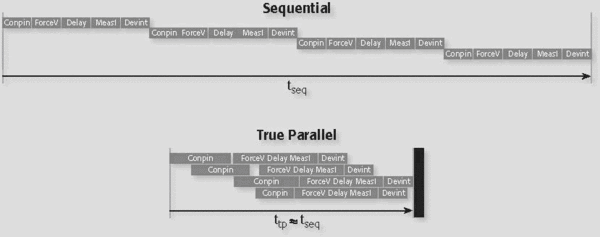Parallel parametric test

The parallel parametric test is an emerging strategy for wafer-level parametric testing that involves concurrent execution of multiple tests on multiple scribe line test structures. If offers the potential for increasing test throughput with existing test hardware, in response to market pressure on fabs to minimize test times. The figure illustrates the differences in the amount of time required to complete tests sequentially as compared to the same tests in parallel.
Advantages
The potential advantages of parallel parametric testing include:
- Cost of ownership advantages: By increasing throughput, parallel test decreases a system’s cost of ownership. The degree of throughput improvement has been documented between ×1.05 and ×3.9, depending on the existing test structure and pad layout as well as the specific combination of test structures within the TEG.
- Test cell capacity advantages: Parallel testing can eliminate the need to add test cells or reduce the number of test cells in use by employing existing hardware more efficiently.
- Impact on overall cost of test: Parallel testing can lower testing costs by reducing the number of test cells required, requiring fewer operators, reducing consumables costs and more.
References
- Keithley Instruments, Inc., Parallel Test Technology: The New Paradigm for Parametric Testing, 2006
This article is issued from Wikipedia - version of the 6/26/2016. The text is available under the Creative Commons Attribution/Share Alike but additional terms may apply for the media files.